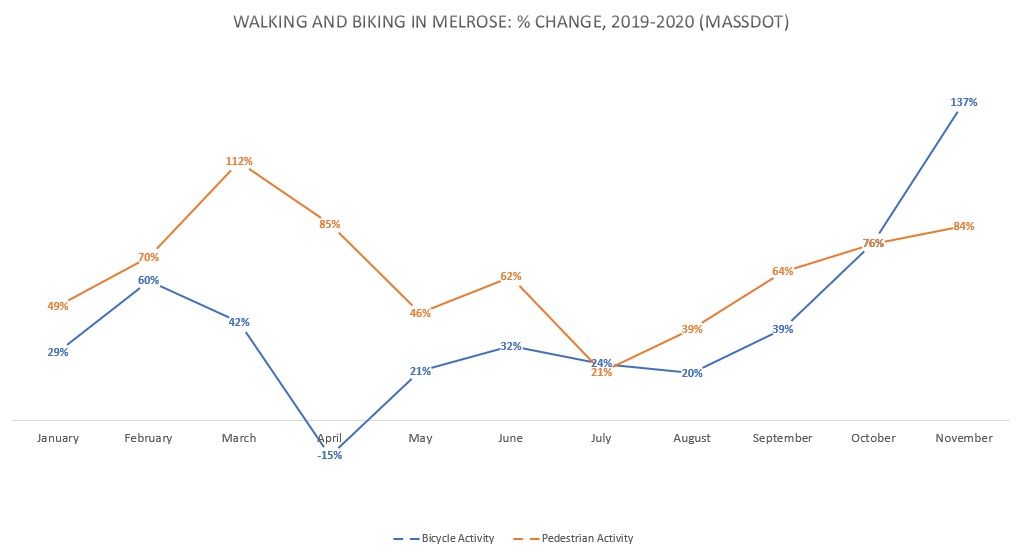Per the state’s MassDOT Mobility Dashboard, both pedestrian and bicycle activity in Melrose were substantially up in 2020 when compared to 2019. People took more walking trips around Melrose in every month in 2020 than they did in the same month in 2019; the same pattern holds true for biking trips, except in April, as the state’s first stay-at-home advisories were coming into effect. In Melrose, walking trips saw the largest increase in the spring months, as the pandemic was taking effect, while relative increases in cycling grew more pronounced through the fall and winter, with people choosing to continue to take bike trips even as cooler weather set in. These latter numbers are extremely promising and could signal a “stickier” trend, with increases being sustained year-round as opposed to being a three-season phenomenon.
This matches local anecdotal evidence and mirrors statewide and national trends, with disruptions from COVID-19 ushering in a “bike boom” across virtually every demographic segment. Promisingly,MassDOT’s statewide cycling and walking data both indicate that people were taking longer, farther trips by foot and by bike, with those trips being more circuitous — for example, fewer one-way commuting trips, and more trips starting and ending at home, as with shopping trips, etc.
We believe it is critical that Melrose take advantage of these trends by increasing investments in pedestrian and cycling infrastructure. Sustainable streets — those which promote walking, cycling, and greater amounts of foot traffic generally — carry clear economic benefits for cities and towns, and as we hopefully emerge from the global pandemic during 2021, it will be absolutely critical for Melrose to invest in our core commercial districts by promoting ways to grow foot traffic to shops and restaurants. Cities and towns also have an unequivocal obligation to immediately seek ways to reduce vehicle miles traveled in order to meet 2050 Netzero goals. The three most obvious ways that small transit-oriented cities like Melrose can promote active transit are through encouraging local shopping trips, school pickups and dropoffs, and last-mile commute links to shift from automotive to non-automotive means.
One of our principal points of advocacy in 2021 will be to encourage the City to promote a central complete streets corridor by adding crosswalks and bike lanes to Lower Main Street. As utility work wraps up between West Wyoming ave and Sylvan Street this year, we have a once-in-a-generation opportunity to make a statement about our priorities by providing dedicated, buffered bike lanes through this corridor, promoting safer travel between our “downtown” to the north and Oak Grove/Pine Banks/Malden to the south. If you’d like to add your voice, join the hundreds of other locals who have signed our petition asking the city to add safety upgrades to Lower Main, or drop us a line to learn how you can get involved in our efforts directly!

